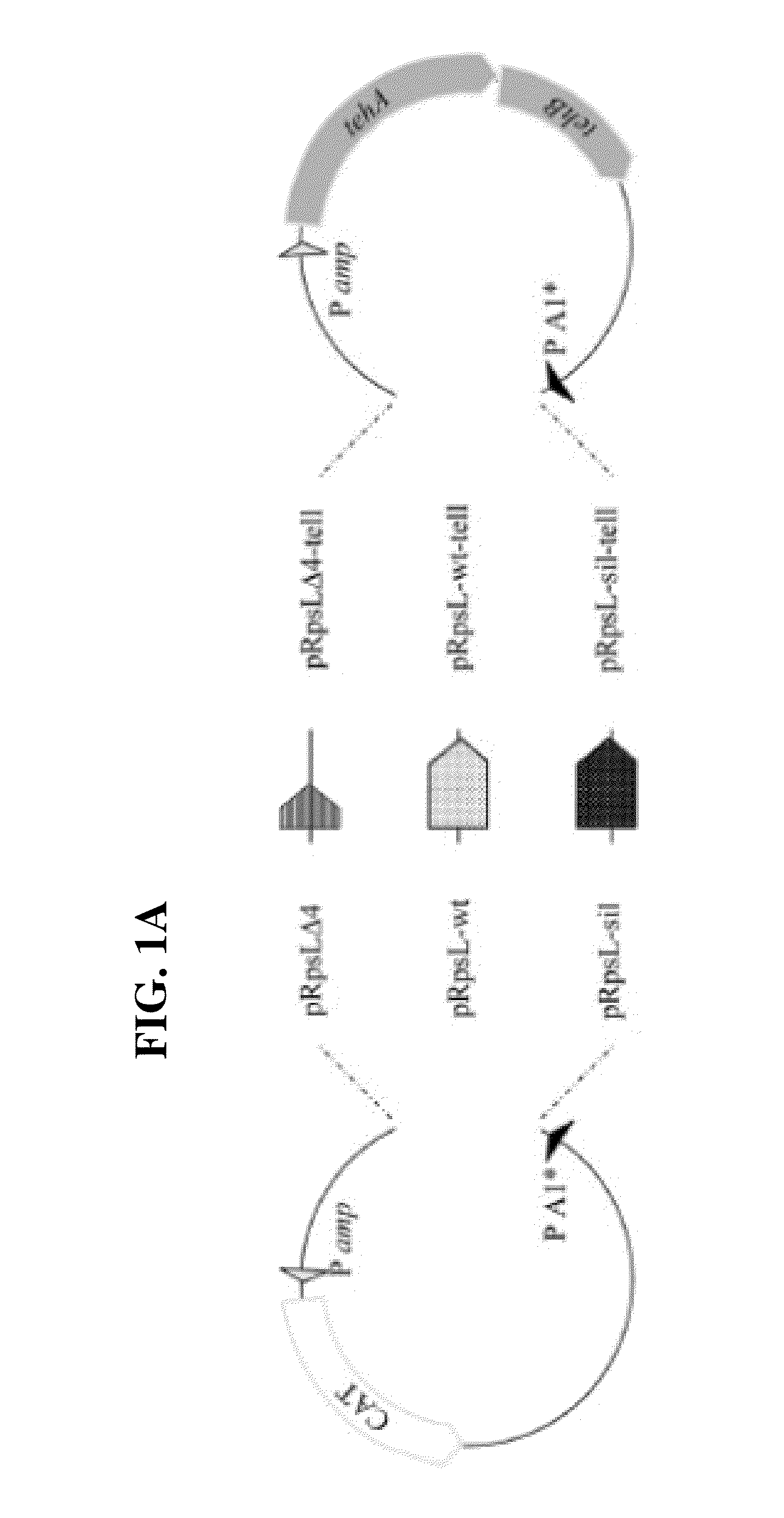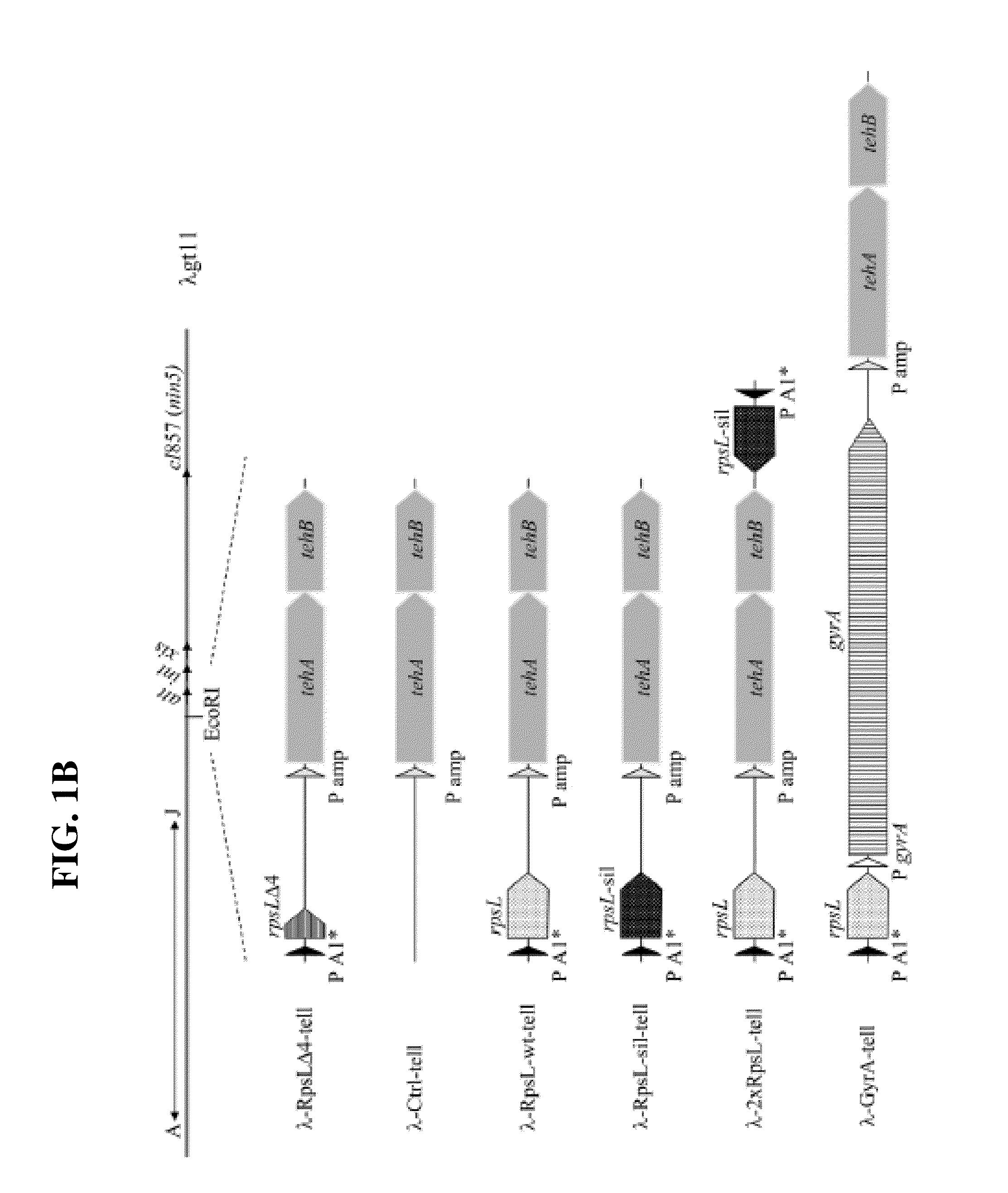Bacteriophages for reducing toxicity of bacteria
a technology of bacteriophage and toxicity, which is applied in the field of reducing, antibiotic resistance in bacteria, can solve the problems of accelerating the development of newer antibiotics, being overrun by the pace of bacterial resistance, and lack of sufficient pharmacokinetic and efficacy studies in humans, so as to reverse the resistance of the bacterium
- Summary
- Abstract
- Description
- Claims
- Application Information
AI Technical Summary
Benefits of technology
Problems solved by technology
Method used
Image
Examples
example 1
Mutations in the Target Gene, rpsL, Constitute a Major Resistance Mechanism to Streptomycin
[0168]The overall goal of this study was to provide a proof-of-principle for a genetic system able to restore drug sensitivity to drug-resistant pathogens residing on hospital surfaces. The present inventors chose, as a first step, to use streptomycin as the model drug. Streptomycin is highly useful as an effective antibiotic against both Gram-negative and Gram-positive bacteria. For example, streptomycin is a mainstay of tuberculosis therapy. However, streptomycin-resistant Mycobacterium tuberculosis emerge during treatment, and 24 to 85.2% of them have mutations in either rpsL or rrs (15). The rpsL gene product, S12, is an essential, highly conserved protein of the 30S small ribosomal subunit. Most of the acquired resistance to streptomycin is due to specific mutations in rpsL that prevent the inhibitory binding of streptomycin to the essential rpsL gene product. The present inventors wanted...
example 2
[0169]Wild-type (wt) rpsL transformed on a plasmid dominantly confers streptomycin sensitivity Minimum inhibitory concentration (MICs) to streptomycin were determined by agar-plate assay (19). In this assay, ˜104 cells are replica-plated on plates with different drug concentrations. The lowest concentration at which there is no visible colony-formation is defined as the MIC. The MICs throughout the study were also measured in a complementary liquid-determination assay, giving a similar readout (not shown). Two representatives of the most common streptomycin-resistant strains obtained above were taken for further study: strains Sm6 and Sm13, harboring mutations in rpsL leading to substitutions of R86S and K88R, respectively. Their MICS to streptomycin were 100 μg / ml and 200 μg / ml, respectively, whereas the MIC of the parental strain was 1.56 μg / ml. These strains were transformed with the plasmid pRpsL-wt, encoding the wt rpsL, or a control plasmid, pRpsLΔ4, encoding a mock gene (a de...
example 3
[0170]rpsL Designed with Decreased Homology to the Wt Allele can Efficiently Restore Streptomycin Sensitivity
[0171]The present inventors propose that the rpsL-containing construct may be transferred horizontally between strains by transformation, conjugation or transduction, as described below. Recombination events between the chromosomal resistant rpsL and the delivered wt rpsL may reduce the efficiency of the construct because it may eventually recombine with an rpsL copy that does not confer sensitivity on the transformed strains (nevertheless, there is no danger that it will confer resistance in sensitive strains as the sensitive allele is dominant). In order to reduce the undesired recombination events between the incoming allele conferring sensitivity and the resistant allele in the transformed cell, the present inventors have designed an allele which cannot undergo homologous recombination with the bacterial copy. Efficient homologous recombination requires identity between r...
PUM
| Property | Measurement | Unit |
|---|---|---|
| temperatures | aaaaa | aaaaa |
| temperature | aaaaa | aaaaa |
| temperature | aaaaa | aaaaa |
Abstract
Description
Claims
Application Information
 Login to View More
Login to View More - R&D
- Intellectual Property
- Life Sciences
- Materials
- Tech Scout
- Unparalleled Data Quality
- Higher Quality Content
- 60% Fewer Hallucinations
Browse by: Latest US Patents, China's latest patents, Technical Efficacy Thesaurus, Application Domain, Technology Topic, Popular Technical Reports.
© 2025 PatSnap. All rights reserved.Legal|Privacy policy|Modern Slavery Act Transparency Statement|Sitemap|About US| Contact US: help@patsnap.com



